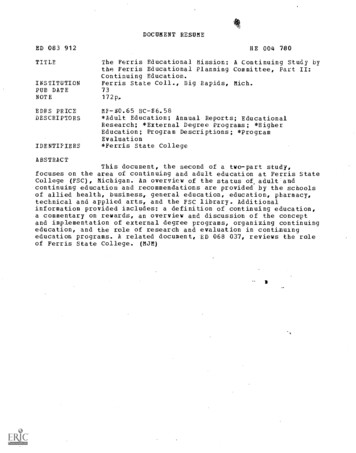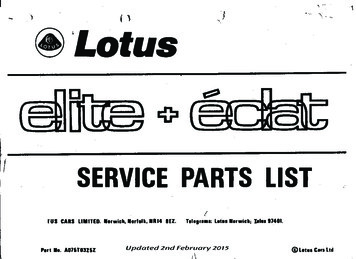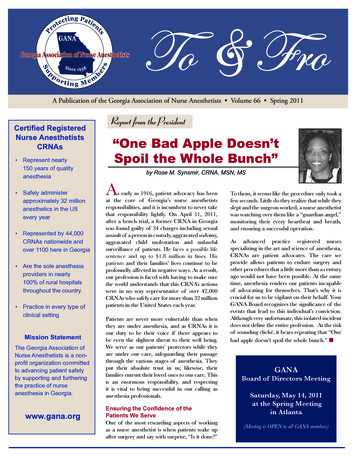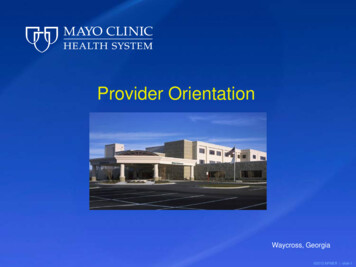
Transcription
DOCUMENT RESUMEED 083 912TITLEINSTITUTIONPUB DATENOTEEDRS PRICEDESCRIPTORSIDENTIFIERSHE 004 780The Ferris Educational Mission: A Continuing Study bythe Ferris Educational Planning Committee, Part II:Continuing Education.Ferris State Coll., Big Rapids, Mich.73172p,M1- 0.65 HC- 6.58*Adult Education; Annual Reports; EducationalResearch; *External Degree Programs; *HigherEducation; Program Descriptions; *ProgramEvaluation*Ferris State CollegeABSTRACTThis document, the second of a two-part study,focuses on the area of continuing and adult education at Ferris StateCollege (FSC), Michigan. An overview of the status of adult andcontinuing education and recommendations are provided by the schoolsof allied health, business, general education, education, pharmacy,technical and applied arts, and the FSC library. Additionalinformation provided includes: a definition of continuing education,a commentary on rewards, an overview and discussion of the conceptand implementation of external degree programs, organizing continuingeducation, and the role of research and evaluation in continuingeducation programs. A related document, ED 068 037, reviews the roleof Ferris State College. (MJM)
THE FERRIS EDUCATIONAL MISSIONA Continuing StudybyThe Ferris Educational Planning CommitteePartCONTINUING EDUCATIONU.S. DEPARTMENT OF HEALTH,EDUCATION & WELFARENATIONAL INSTITUTE OFEDUCATIONTHIS DOCUMENT HAS BEEN REPRODUCE() EXACTLY AS RECEIVED FROMTHE PERSON OR ORGANIZATION ORIGINATING IT POINTS OF VIEW OR OPINIONSSTATED DO NOT NECESSARILY REPRESENT OF F iCI AL NATIONAL INSTITUTE OFEDUCATION POSITION OR POLICYSpring, 1973FILMED FROM BEST AVAILABLE COPY
FOREWORDIn September, 1971, the members of the Educational Planning Committeeheld a retreat to determine the most pressing subjects pertinent to theFerris educational mission to which they shoula address themselves duringthe 1971-72 academic year.In subsequent meetings, content areas wereidentified and outlined, then allocated to particular members for studyand analysis.The document, Partrealized from this effort.I"Obligations andDirection," wasA reading copy of it is on reserve in theLibrary.This document, Part II "Continuing Education," is a pathfinderfor the subject.It continues the traditions of study and reportingas Indicated in 1971-72.Readers will find, as appropriate, both specificand general directions which pertain to the Schools and to College-widequestions.Recommendations are contained in most of the sections.of them can also be had by examination of the annual report.SECTIONS, TITLES, AND AUTHORSSectionIThe School of Allied HealthDr. Rouman, Miss Siebers11The School of BusinessDrs. Goodwin, Moss, and Wigglesworth111The School of General EducationDrs. Bond, Milton, and SalingerIVThe School of EducationPartI- Dr. GriffinPart II - Drs. Griffin and HoeksemaVThe School of PharmacyDrs. Orr and TindallA review
VIThe School of Technical and Applied ArtsMr. Jarvi and Mr. ParsonsVIIThe Ferris State College LibraryMr. DickinsonVIIIA Definition of Continuing EducationDrs. Griffin alietTrrIXCommentary on RewardsDr. GriffinXExternal DegreePartI- Concept and ImplementationDi. WiggiesworthPart II - An OverviewMr. PeticolasXIOrganizing for Continuing EducationEPC CommitteeXIIThe Role of Research and Evaluation in a Continuing EducationProgramDrs. Griffin and SalingerThe School's reports were read by a sub-committee composed ofDrs. Bond, Griffin, Milton, and Orr.by the Committee.College-wide sections were reviewedDr. Rankin aided the Committee by providing a. typedfirst copy.The editorial task was shared by Drs. Griffin, Kakonis, and Salinger.John Johnson served as advisor to the EPC throughout the entire year.William Wenrich provided the initial statement to the Committee on ttA:subject.1fDr.Dr.
SECTION ITHE SCHOOL OF ALLIED HEALTHThe School of Allied Health is committed to the philosophical conceptof continuing education.There is tremendous need and demand for a viableinnovative continuing education program at Ferris State College.gram can only become a reality as the institutionsubstantial commitment to this program.This pro-is willing to make aTo make this system truly effective,support is required in the following areas:I.II.Continuing Education Coordinator for Ferris State College;Directors within the six schools of the college.We envision the coordinator as being just that; a coordinator orfacilitator.This office would function to serve the erectors ineach of the six schools of the college.The director in each schoolwould serve as chairman of that school's continuing education committee.This person along with the committee would establish thepriorities for continuing education in that school.The directorwould then relate these priorities to the C.E. Coordinator for hisassistance in consummating this program.Ill.Logistical Support and FacilitiesExperience has shown that our school does not presently have thephysical facilities to conduct an adequate continuing educationprogram.We are aware that when the new Allied Health facility isconstructed many of our existing physical plant problems will besolved.Further, the "class room without walls" concept is mostadaptable to our program areas.A'
IV.Instructional SupportInstructional and administrative personnel are available for limitedprojects during the academic year and could handle a number of projectsThis additional time can not be consideredduring the summer months.a part of the regular faculty workload.V.FundingFunding for the Continuing Education programs will vary according to theclientele being served.Programs with flexibility in funding could possi-bly use consultant fees for the instructors, with registration fees adjustedto cover the expense of the program.Programs lacking resources willrequire that the instructor be paid at a basic rate and the registrationfees adjusted to cover these costs.SUPPORTIVE INFORMATION:More than half the jobs and occupational areas open to young peoplestarting on a career today did not exist when their fathers were young men.Accordingly, the W.K. Kellogg Foundation has stated that a worker enteringthe Allied Health Field at age 20 will go through seven major retrainingperiods in a forty-year career.The faculty and administration of theSchool of Allied Health recognize their role in providing workshops, shortcourses and inservice programs for this generation of Allied Healthclientele.The school agrees that these services can best be providedthrough a direct program of continuing education utilizing all of the resources (both personnel and facilities) to the benefit of all in our WestMichigan area who may find them useful.In fact, over the years programsin health teaching techniques, home health aid, food service, migrant labor,optics, and many other areas of concern have been conducted by our faculty.
3We have established the present program needs of the School of AlliedHealth in continuing education to include:1.Continuing Education for the internship directors who are in the field.For example, in Environmental Health we could utilize workshops forrepresentatives from the County Health Departments that provide theinternship experience for our students.2.Continuing Education for our faculty to keep them abreast of changestaking place in their fields, both philosophically and technically.For example, a most presr'lg issue is the expanded duties for dentalassistants and dental hygienists.3.Continuing Education for the alumni of our programs.4.Continuing Education with the hospitals in the West Michigan area.Themajor thrust in this area could be handled by the Technical Nursingprogram and the Health Services Management Program.SUMMARY:Our survey and follow-up contacts have led us to the conclusion thatFerris State College must make a commitment to provide funds for a college-wide coordinator, continuing education directors for each of the schoolsand basic support monies for programs which may not be self-supporting.Therole of the director would be to develop his school's priorities for programswithin a college wide framework using the assistance and consultative skillsof the coordinator.Our school suuports such a concept, which would be invaluable to our pre sent school-wide continuing education committee.within the Allied Health Field.Priorities change rapidlyClose surveillance by those at the heart ofthe educational process is required to maintain the flexibility necessary tomeet the needs of our clientele.
FERRISSTATECOLLEGEBig Rapids, Michigan 49307616/796-9971October 26, 1973ERIC - Higher EducationSuite 6301 Dupont CircleWashington, D. C. 20036Dear Sirs:The Ferris State College Educational Planning Committee wishes toinclude Part II of The Farris Educational Mission in the ERIC system.While Part I dealt with the role of the college, Part II focusesits attention on the area of continuing and adult educatio7".We hope that other colleges might benefit from the findings andrecommendations that the Educational Planning Committee has set forthin this document.Thank you for your interest in this matter.Sincerely yours,Raymond B. DickinsonSecretary,Educational Planning CommitteeFerris State College
4As a result of our survey of faculty opinion, we believe the ultimatepriority decisions should reside within the individual schools and notwithin a college-wide committee.
5SECTION IITHE SCHOOL OF BUSINESSA survey of the geographic area* served by the School of Business wouldindicate several strong markets for continuing education activities.Thesemarkets are:1.Retail2.Wholesale and manufacturing3.Educaticn4.Health services5.GovernmentA number of the'Markets can be subdivided.For example, the retailmarket can be delineated according to product and service designatiorcs.Thegovernmental market, which is essentially restricted to the local governmentallevel, would have general and operational as well as human service needs.The listing also suggests the possibilities for interdisciplinary approachescombining the resources of several. Ferris divisions.To illustrate, the Schoolof Pharmacy and the School of Business could combine their resources in the areaof variety goods and drug merchandising, while the School of Business and theSchool of Trade and industrial Arts could serve the needs of gasoline servicestations and food service establishments.The tables in Appendix A, which present data relative to the countieswithin the School of Business target area, warrant the following remarks:*Antrim, Benzie, Charlevoix, Clare, Emmet, Grand Traverse, Gratlot,Ionia, Isabella, Kalkaska, Kent, Lake, Manistee, Mason, Mecosta,Missaukee, Montcalm, Muskegon, Newaygo, Oceana, Osceola ,.Ottawa, Wexford.
6Table I.Breakdown of Retail IndustryTable 1 shows that there are about 9,500 retail establishments with over51,000 paid employees located in the northwest lower Michigan multi-countyarea believed logically served or servabie by the School of Business.ifonly one percent of these businesses were to be Interested in sending oneor more persons to seminars or short refresher courses, they alone wouldprobably be sufficient to fund and to justify the development of a programof courses to meet their needs.Table II.Retail Trade for Selected Michigan CountiesTable II to some extent classifies the retail establishments in thetarget area by type of business.This would suggest the possibility oftailored services or programs to meet the needs of establishments with commonAcharacieristics, such as eating and drinking places.The possibility of Schoolof Business programs in conjunction with certain other of the Schools atFerris, is also suggested by the table.Table III, Wholesale EstablishmentsTable III indicates the presence of about 1,700 wholesale establishmentswith 18 to 19 thousand employees in the market area.Hopefully at least 2 or3 percent of these establishments might be interested in continuing educationprograms.If this many would respond by sending one or more persons to pertinentprograms there would probably be a sufficient number to justiry and fund programsspecifically developed to meet their needs.
7Table IV.Selected Services (Industries)Table IV shows over 6,000 selected service-type business establishmentsin the target area with over 14,000 employees.Unquestionably many of thesehave proprietor or employee educational needs similar to those of otherbusinesses, such as retailers and wholesalers.Programs could be designed toserve service industries In combination with one or more of the other groups.Might not, for example, a business practices and accounting seminar mounted inconjunction with the cosmeato/ogy department, be well received by beauty parloroperators?Or a similar undertaking, for automobile service and repair shops,be developed in conjunction with Technical and Applied Arts?Table V.Educational ServicesTable V supplements Table IV by showing the number and location of variousservice type enterprises such as hotels, garages, beauty shops, etc., indicatedby county.No comment is necessary.Table.V1. Manufacturing ResearchManufacturing establishments in the target area are indicated in label Vito exceed 2,100 in number and to employ about 140,000 persons.The productionmanagement, labor relations, international business, financial and salesmanagement and other activities of these factories can be matched with theseveral departments in the School of Business which, obviously, have theabilities and capacity to develop programs of value to the manufacturers withinthe PSC target area.Itsufficient number of persons were to become interested,say 2 or 3 percent, funding might not present a serious obstacle for this grOup.The market potential appears to be present.
Table VII.Selected Major CitiesTable VII supplements Table VI in that it gives the location by city ofvarious types of manufacturing enterprises within the target multi-county area.he possibility of specialized types of needs to be met on the part of plastics,printing, refrigeration, furniture, machinery and other types of enterpriseswould seem to exist.Some of these could again perhaps be best met by jointundertakings, such as between the School of Business and of Technical andApplied Arts.Table VIII.Number of Local Governments andEmployeesAnother probable market for continuing education experiences lies in thegovernmental as contrasted to the private sector of the economy.Table VIIIshows that there are well over 800 governmental or quasi-governmental unitswithin the northwest lower Michigan multi-county area.These would include suchentities as the county governments themselves, city and village governments,school and special purpose districts.Doubtless many of the people In such'governmental units could benefit from short refresher or other courses, orsessions in such areas as taxation, accounting, business and government,financial management and other studies easily within the province of the Schoolof Business to develop and administer.Table IX.Labor Force for Selected AreasTable IX suggests the numbers of persons in governmental units who mightbe involved potentially in continuing education fields.The table providesdata on the two of the most populous centers within the area.While many ofthe local government employees probably are teachers and others who would perhapsbe better served by other Ferris divisions than the School of Business, thereare no doubt numerous administrators and technical people who would be wellserved by the Business School.
9Table X.Payrolls of Local GovernmentsTable X serves to give some idea of. the magnitude of the local governments-oll standpoint, educational and otherwise, wlthin the multi-countyfrom aarea.Table Xl.Wage and Salary WorkersTable XI indicates there are over 60,000 governmental employees in thetarget area.Table XII.Total Labor ForceThe total labor force in the multi-county target area is shown by TableXII to approximate 500,000 people.While the number of these not includedwithin previously mentioned tables is no doubt much smaller, there could wellbe some residue there from so far as the .potential market for School of Businesscontinuing education services is concerned.Table XIII.Demographic Statistics on CountiesTable XIII provides useful basic information for persons planning acontinuing education program.The data include the numbers of people andtheir occupations, education and Income within specific counties of the targetarea.This data could provide clues, for example, as to the numbers of peoplewho might be qualified to take college level continuing education courses on acredit basis.That very large numbers of people in the area might not beable to pay very much or anything at all for educational experiences is alsosuggested by the data.continuing educationThis Is a factor which could pose problems so far asprograms, aimed at the general public, are concerned.
10Tables XIV and XV.Educational DataTables XIV and XV provide additional data with respect to the schoolsystems within the multi-county target area.This data can be useful shouldcontinuing education programs be considered or. undertaken for school administrators,school board members, teachers, or all those concerned with other aspects of localschool system operation.
Further Suggestions for Course OfferingsPresent course offerings in the School of Business provide ampleopportunity for persons within the target area to gain career preparationor to implement career change.Entry points into the curriculum are numerousand conveniently spaced.Courses for continuing professional education are presently being offered.Students may take courses in preparation for the following professionaldesignations:Certified Public Accountant, Chartered Life Underwriter,Chartered Property and Casulty Underwriter, and Certified Court Reporter.Many courses are and can be given which would enrich leisure timeactivities.Some of these courses are:personal typing, note taking,business correspondence, personal finance and income tax preparation, officemachine operation, consumer product information, interior decoration, dataprocessing, and basic business routine operation.The steady march of developments in the data processing and computerapplication fields suggest substantial opportunities for continuing educationprograms.in addition, timely courses dealing with the impact of businessdecisions on ecological factors have been proposed for inclusion in thestandard curriculum as well as in the continuing education program.A report published in 1970 titled "A Bureau of Business Services forFerris," authored by Dr. Edwin Wigglesmorth, highlighted the potential forbrief workshops and seminars in the West Michigan target area.persons in the target area were surveyed.BusinessSpecifically, business personswere questioned about their desire to become involved In seminars and workshops, and their perferences for seminar and workshop topics.The response
12from the business community was immediate and enthusiastic.At this writing,there would be every reason to believe that the 1970 findings are still valid.Therefore, it can be concluded that sponsorship of continuing educationprograms await the initiative of the faculty and administration of the Schoolof Business.The Medium for ProgramsIn September 1972, the Educational Services Program committee was formed.The committee consists of one member from each instructional department inthe School of Business, two faculty members serving as publication co-editors,a Program-Coordinator on partially released time, a secretary, and the sharedservices of an Administrative Assistant.On February 20, 1973, detalled.jobsummaries, dutiet and responsibilities were proposed and unaminiouslyapproved by the committee.Exhibit 11, Appendix B. illustrates the structureof the Educational Services Program.Approximately twenty-five percent of the School of Business faculty.expressed a willingness to participate in the committee activities.Inthis sense, participation would consist of performing consulting work,conducting workshops and seminars, giving on- campus and off-campus instruction,and speaking to interested groups on a variety of topics,Exhibit III,Appendix B, indicates the scope of services offered by the Educational ServicesProgram.At the present time, the Program Coordinator is visiting firms andorganizations in the target area to determine education needs and to arrangeprograms.RecommendationsBecause the market area for the services of the School of Business atFerris has been shown in two studies (the present one and the report prepared
13in 1970 by Or. WiggledWorth*) to have more than adequate potential forsupporting a broad range of continuing education activities, the followingrecommendations are made:1.That current, on-going efforts of the School of Business EducationalServices Program be strengthened.2.That the Educational Services Program personnel be directed to studymethods of expanding publicity for this program.3.That each department within the School of Business consider thedevelopment of continuing education bycooperative departmental effort,advised and assisted by the Educational Services Program personnel4.That every effort be made by the personnel of the EducationalServices Program committee to coordinate School of Business educationextension programs with other Ferris divisions.4*A bureau of Business Services for Ferris, Ferris State College, BigRapids, Michigan, June 1970. -.See page 170 for regpmmendatiOns.
SECTION IIITHE SCHOOL OF GENERAL EDUCATION"Lifelong learning is essential in a society in which career patterns arechanging and new developments are coming so rapidly in all fields," keynotespeaker Robben W. Fleming, President of the University of Michigan, recentlytold the Region IV Conference of the National University Extension Association(NUEA) at its opening session.The role of the School of General Education of Ferris State College inproviding opportunities for lifelong learninc falls into three broad categories.Its first function is that of a service to other schools since GeneralEducation can offer support courses for their programs.In this connection,the course offering will be largely determined by the schools being served.The second function will be to provide non-vocational courses planned forparticular interest groups.The School of General Education has a uniqueopportunity to be of community service in such areas as programs for the agingand education for leisure time.The third function would be to expand anddevelop programs relating to the several degree curricula offered in GeneralEducation.There will be increasing need for Workshops for law enforcementofficers, journalists, public administrators; for short courses for paraprofessionals in day care centers and those working with the aged, as theseprofessions increasingly demand current knowledge in a period of rapidchange and expansion.Programs for the AgingPopulation to be served:Senior Citizens from Mecosta and OsceolaCounties and portions of Lake, Newaygo, Wexford and Montcalm counties,Curriculum:Personnel:Short courses and workshopsStaff available from present faculty.
IsThese courses could be designed primarily for persons in their lateryears.Programs could include:Health for Senior Citizens, RetirementLiving, Travel Lectures, Art and History related Tours.Education for Leisure Time-Adult EducationPopulation to be served:Adults from Mecosta and Osceola Counties andportions of Lake, Newaygo, Wexford, and Montcalm Counties.Curriculum:Personnel:Short Courses and workshopsStaff available from present facultyOffered primarily for leisure time enrichment, the current programcooperates with the local public schools program; courses are offered eitherby Ferris or the public schools depending on the most appropriate settingand use of facilities.In his address Fleming added, "The need for lifelong education is great."Calling attention to the fact that leisure time continues to increase in mostsegments of society, he pointed out that we need to provide opportunities forpeople to develop individuality. "Individuals are already seeking those thingsthat bring life satisfactions rather than those relating only to career goals,"he said."This approach could open up new avenues of extension programmingin the arts and humanities." At Ferris such programs could include such finearts courses as Art Appreciation, History of Art, Drawing and Sketching, Design,Ceramics, Pottery, Sculpture, Jewelry and Metalcraft, Basic Photography, ColorPhotography, and Creative Writing, Liberal Arts courses could include: Convetsational Spanish, Appreciation of Literature, World Literature, Shakespeare,Theory and Practice of Acting.Music Department offerings could include, inaddition to Band day, Summer Band Camp, and concerts, expanded programs inmusic appreciation and community participation in musical groups.
16Journalism AssociatesPopulation to be served:Working Journalists kn Central WesternMichigan, teachers seeking certification as journalism teachers.Curriculum:Degree programs, writing and makeup workshops, workshopsin publicity release writing, public relations, newswriting, and industrialediting,Personnel:Staff available from present faculty.Public Administration AssistantsPopulation to be served:Non administrative municipal and countyemployees in Central Western Michigan who seek administrative positionsor upgrading of their present position.Curriculum:Personnel:Degree programs, workshops.Staff available from present faculty.mice SciencePopulation to be served:City, county, and state law enforcementofficers of Central Western Michigan.Curriculum:Personnel:Refresher courses, workshops, degree programs.Staff available from present faculty.General CoursesOther departments of the School of General Education currently offerand are in a position to expand various programs within their respectivedisciplines.Population to be served:Adults from Mecosta, Osceola Counties andportions of Lake,Newaygo, Wexford and Montcalm Counties and communitypersonnel beyond these for specific offerings.Curriculum:Personnel:Short courses and workshopsStaff available from present faculty.Some of the existing or future program areas include these:
17Among the members of the Department of Biology are People who couldinstitute programs in conservation and the broader areasof the environmentand environmental problems and staff who could work on problems of birthcontrol and social diseases.The Department of Physical Science could provide resource people for highschool in-service teacher training programs and advisors for communitiesconcerned over nuclear power plants such as those at Charlevoix, Ludington,and Muskegon.In the Department of Language and Literature, there have been communication workshops and reading conferences.It is possible that Ferris couldexpand not only these special services but institute a program designed toappeal to outstanding students.The Department of Physical Education now offers leadership in coachingcourses, in first aid, in special workshops for trainers involved in highschool athletics.In addition, this department sponsors several specialprograms in swimming and cheerleading.The Department of Mathematics offers in-service training for teachers,a special program of math for parents, and hosts a regional math conference.The Department of Social Sciences has the resources for special offeringin political science; another lecture series relating to the social sciencesmight be possible and desirable.It would be feasible for Ferris to set upa continuing information center for small town administrators. that wouldprovide expert advice or interpretation of special regulations relating tothe environment, to fiscal problems, to police administration, as theneeds for these forms of information might arise.The School of General Education has the recourses to provide post-degreein0.service workshops in the various areas of human services.Demand and opportunity alike exist for the School of General Education.It only remians for the personnel involved to expand existing programs and to
18develop new ones suited to the requirements of the non-urban populationin Mecosta and adjacent counties.A wider area of service would probablybe restricted to specialized programs instituted to meet the needs arisingout of particular technical requirements relating to the biological,physical and social sciences.
19SECTION IVTHE SCHOOL OF EDUCATIONPART 1This report explains a rationale for continuing education programswithin the School of Education.Functionally is serves a way ofconceptualizing the field, particularly with respect to the learners.Readers are encouraged to examine other rationales and to otherwise createtheir own concept of purposes and interactions.However, it does notattempt to provide a detailed "how to do it" outline.The rationale begins with certain identifying questions.I.11.III.IV.They are:What educational purposes should the School seek to attain?What type of learning experiences can be presented?How can these experiences be organized?In what manner will it be determined whether these purposes7arebeing reached?The report suggests a means of examining these questions.will vary with program actions and level of involvement.AnswersThe explanationgiven to the procedures by which one answers questiohs constitutes a sourceof knowledge.The Association for Curriculum Development and Supervisionls 1962yearbook, Perceiving, Behaving, Becoming:A New Focus for Education%is recommended reading, as it presents a field approach to education.Like-wise, Ralph W. Tylers', Basic Principles of Curriculum and Instruction2,can aid as a guide for readers regarding need analysis.Other readingswill be mentioned in the context of this statement.I.What Educational Purposes Should the School Seek to Attain?The question can be examined by first stating that i
major thrust in this area could be handled by the Technical Nursing program and the Health Services Management Program. SUMMARY: Our survey and follow-up contacts have led us to the conclusion that Ferris State College must make a commitment to provide funds for a college-wide coordinator, continuing education directors for each of the schools










